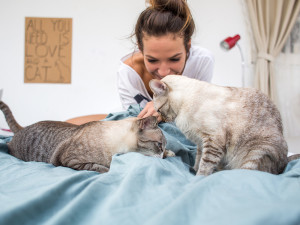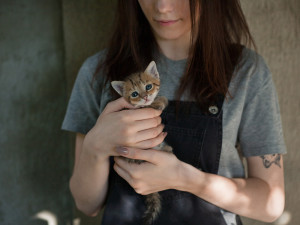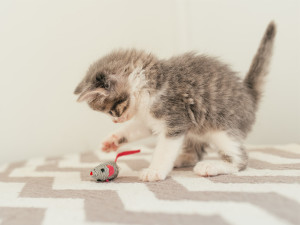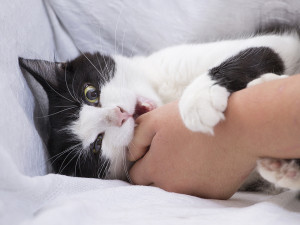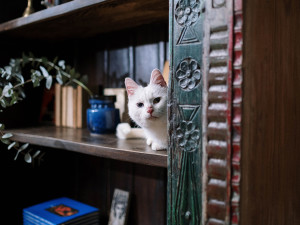How to Introduce Your Adult Cat to a New Kitten
Whether you have a friendly feline or a senior sourpuss, it’s important to help your cat adjust to a new kitten in the house
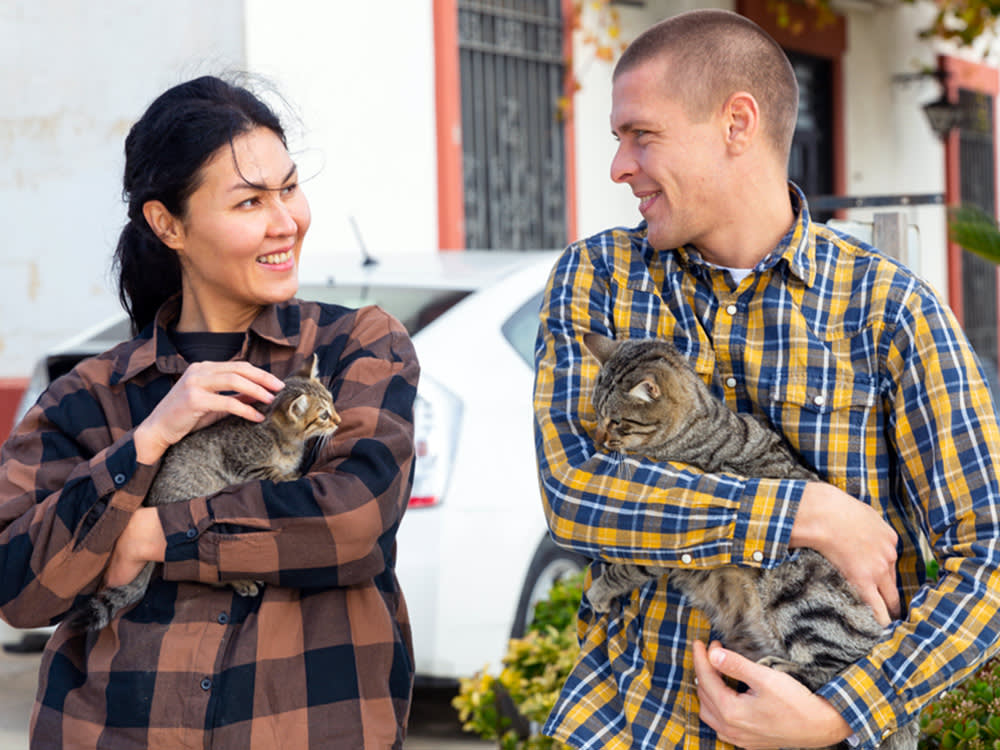
share article
We all love a kittenopens in a new tab, and you might be tempted to add one to your householdopens in a new tab. No matter the circumstances, bringing home and raising a kitten comes with its challenges, from getting the all-important vet visitsopens in a new tab booked in to cleaning up those little accidentsopens in a new tab, but things can get more complex still when you throw an adult cat into the mix.
Cats are quite solitary creaturesopens in a new tab, and often won’t take kindly to being required to share their living space with someone else all of a sudden – particularly a smaller cat who might not yet understand boundaries! But, with some careful planning, it’s perfectly possible for your adult cat to learn to at least tolerate a new kitten, even if they may never be the best of friends. And here’s how.
What to consider before getting a kitten
If you haven’t yet made your mind up on whether or not to get a kittenopens in a new tab, there are a couple of things to think about first.
Do you have the space for two cats? Cats aren’t large animals, but at the same time, each cat will need a minimum of around 18–20sq ft in the house, but more is always preferable –particularly if your cats don’t have any outdoor spaceopens in a new tab. It can be helpful to give your adult cat access to spaces, perhaps those higher up, that your kitten can’t get to, too.
Will you have the time and money to commit to making the transition into a two-cat household easier for everyone – particularly the cat you already have? For the safety and happiness of both cats, it’s worth taking as much care as you can when it comes to introducing them to each other, from carefully supervising the first few meetings to buying everything your kitten needs. This isn’t really something that you can do by halves.
Introducing a cat to a new kitten – first steps
Begin by setting up a room or zone that’s a safe space for your new kitten – ideally, a spare bedroom (if you have one). Make sure it’s got everything your kitten needs, so that they can settle into their new home at their own pace. In there, you should make sure they have food and water bowls, a litter tray, a scratching post, bedding, some toysopens in a new tab, and some places to hide if possible, too.
Scent-swapping is also important. Before both cats actually meet, get one cat’s scent on a cloth and give it to the other cat to investigate at their leisure and vice-versa. This is an important step to help your adult cat in particular get used to the scent of the new kitten.
“When introducing the two cats to one another, it should be done with a barrier that they can see and smell each other through, but not touch each other,” explains Dr Anna Foreman, Everypaw Pet Insuranceopens in a new tab’s in-house vet. “This will allow them to assess one another without the risk of a fight breaking out.”
She recommends using a pheromonal spray like Feliway Friendsopens in a new tab in this sort of scenario, as it’s proven to lower tension in households with multiple cats.
When you think your kitten and your adult cat are ready to meet face-to-face, remember not to force them. They should both have routes to leave the meeting, whether that’s by going into another room or getting onto a higher platform. At first, keep meetings short and make sure there are plenty of treats and toys around.
For two cats, buy two of everything
“If you have two cats in a household, it is important to have multiple litter trays – ideally one more than the number of cats to prevent resource competition,” says Dr Foreman. This goes for food and water bowls, too, ideally. If you can, it’s a good idea to put them in different places around the home, but this will of course depend on the space you have.
To that end, it’s a good idea to feed your cats separately, too, and make sure your kitten can’t get to your adult cat’s food. This will make your adult cat feel more comfortable and at ease, rather than feeling as if there’s an intruder in their space. And, your cats will likely have different food to begin with, so it’s best to make sure they both keep to their own.
It’s also a good idea to buy a diffuser like Feliway, which uses the pheromones associated with comfort and safety to help relax cats and reduce anxiety, if you haven’t already. It can be used during initial introductions to help the cats feel more comfortable around each other, but also later on if any conflict or tension arises.
Be mindful of your older cat
Has your older catopens in a new tab had a bad experience with other cats? If your adult cat has had past negative experiences with other cats, whether previous cats you’ve owned, cats they lived with before they came to you, or even just cats in the street, you might need to be more careful and considered in how you manage the introductions.
Likewise, you might need to be extra mindful if you have a senior catopens in a new tab at home, particularly if they’ve been the only cat for many years, or even their whole life. They might struggle to cope with a small, high-energy kitten. So, particularly if you have a senior cat, it’s important to tire your kitten out – play with them lots, so they’re more likely to give your senior cat a break!
And while kittens are seriously cute and getting a new cat can be exciting – though it should go without saying – make sure you keep things consistent for your older cat. Still give them lots of fuss and attention, not ignoring them in favour of the kitten. Even if your kitten takes up a lot of your time with things like training and vet visits, your older cat still deserves the same TLC it’s used to. “It’s important to look out for signs of long-term stress in both cats – for example, overgrooming or repeat episodes of cystitis,” says Dr Foreman. “Stress can cause significant medical issues in some cats, and so the temperament of the original cat should always be considered before another cat is introduced to the household.”
She explains that, if a cat is already dealing with stress-related issues like these, the added stress of another cat being introduced could exacerbate them. Likewise, you may be more likely to come across issues with a sensitive or easily-stressed cat.
But in many cases, a senior cat or one who’s had previous negative experiences will come to get on with a new kitten after some careful, gradual introductions. But there are also stories of people deciding to rehome kittens after their adult cats just don’t get on with them. For some cats, it’s simply better for them to live in one-cat households, and that’s okay!
Signs your cat is unhappy
When introducing cats to each other, you should be prepared to end the meeting if they appear uncomfortable. And there are a few tell-tale signs to look out for, including:
staring
hissing, growling or loud vocalisations
dilated pupils
swishing tails
flattened ears
piloerection (fluffed-up tail and arched back)
hiding
swatting or biting
It’s better to be safe than sorry, so don’t be afraid to remove your cats from the situation if you think things are going south. Doing so could prevent plenty of stress and conflict, or even injury. Dr Foreman says that, if a fight does break out, the cats should be separated carefully, without putting yourself at risk. If there are any wounds or bites, the affected cat should see the vet as the bacteria from the other cat’s mouth or claws could lead to abscesses.
Ultimately, says Dr Foreman, “It will take time to successfully introduce two cats to one another. They may not become best of friends and may simply tolerate each other’s presence.”
However, if you’re prepared to put the work in now, you’ll reap the words going forward and your kitties are more likely to have a long, happy time together.

Adam England
Adam England is a lifestyle and culture journalist who has written for publications including PetsRadar, Verywell Mind, People and Healthline. When he’s not writing, he might be visiting his parents’ Golden Retriever, looking up cats for adoption, or getting into arguments over music.
Related articles
![cat playing fetch]() opens in a new tab
opens in a new tabHow to Train a Kitten to Fetch
Move over, pups. This is a cat’s game, too
![Cat making a disgusted face.]() opens in a new tab
opens in a new tab7 Scents Your Cat Probably Can’t Stand – Plus, a Few They Love
Their noses are as powerful as they are cute
![A kitten playing with a mouse cat toy.]() opens in a new tab
opens in a new tabHow to Keep Your Kitten From Making You the Toy at Playtime
Your cat deserves to play, but you deserve to walk away unscathed
![cat biting person's hand]() opens in a new tab
opens in a new tabWhy Did My Cat Bite Me?
Don’t live in fear of your feline overlord. A vet explains why cats bite (and what you can do to avoid their wrath)
![Extremely blissed out cats on a psychedelic background]() opens in a new tab
opens in a new tabHow Catnip Blisses Out Cats
I’m so high right meow
- opens in a new tab
Why Is My Cat Hiding?
No, they’re not on the lam. Here are four reasons your cat might be MIA

